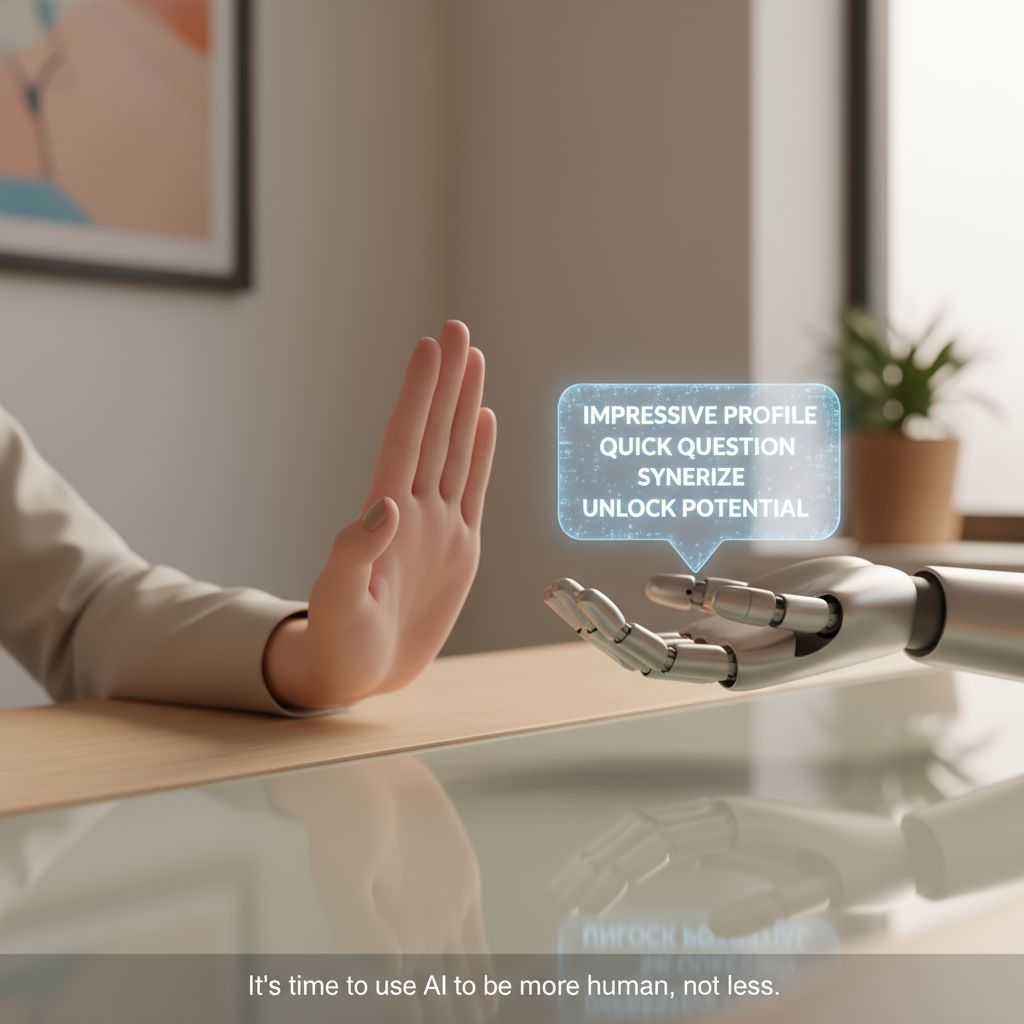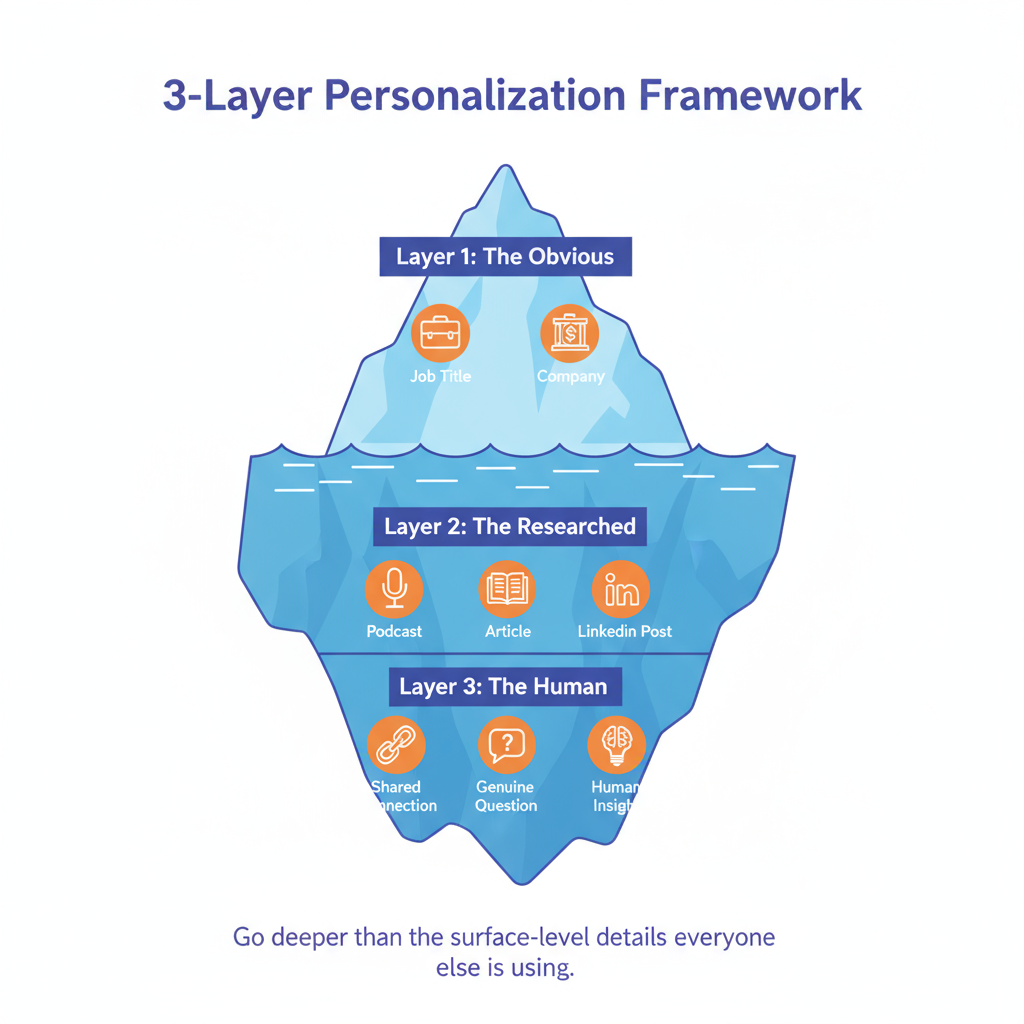Your LinkedIn inbox is a battlefield. It’s cluttered with robotic, copy-paste AI messages that all start with "I saw your impressive profile..." and end with an instant archive. You know this approach is broken, yet the pressure to connect with high-value clients is relentless. What if you could use AI not to create more noise, but to build a surgical tool that identifies and crafts the perfect message for your ideal client, turning a cold shoulder into a warm conversation?
Key Takeaways: Your Edge in a Noisy Inbox
- Stop Sounding Like a Robot: Learn to use AI as a research assistant, not a ghostwriter, to find unique personalization points that generic tools miss.
- Implement the 3-Layer Personalization Model: Go beyond name and company to connect on a human level, dramatically increasing your reply rates.
- Find Your Ideal Clients Faster: Discover how AI tools can triage thousands of profiles to surface the decision-makers who are most likely to need your skills.
- Build a Credibility Hub: Understand why effective outreach is only half the battle and how to direct prospects to a compelling professional page that closes the deal.
- Protect Your Account: Learn the difference between smart automation and spammy behavior that could get your LinkedIn account restricted.
 It's time to use AI to be more human, not less.
It's time to use AI to be more human, not less.
Why Your Current AI Outreach is Failing (and How to Fix It)
Let's be honest. The first wave of AI outreach was about volume. It armed everyone with the ability to spam thousands of people with low-effort, slightly-tweaked templates. The result? Decision-makers are now highly skeptical of any unsolicited message. According to recent sales data, hyper-personalized messages can see up to a 35% higher reply rate compared to generic templates. The game has changed from who can send the most, to who can be the most relevant.
The fix isn't to abandon AI; it's to upgrade your strategy. Instead of using AI to just automate sending, you need to use it to automate *research and insight*. This is the core of the anti-spam playbook: using technology to uncover human connection points at scale.
Before and After: The Impact of Smart AI
- Before: A generic message mentioning a prospect's company and job title. Result: 1% reply rate, often marked as spam.
- After: A message referencing a specific point they made on a recent podcast, followed by a thoughtful question. Result: 20%+ reply rate and genuine conversations started.
The 3-Layer Personalization Framework
To consistently craft messages that get replies, you need a system. Generic advice like "personalize your outreach" is useless without a framework. Here’s a simple, powerful model to structure your research and writing process.
 Go deeper than the surface-level details everyone else is using.
Go deeper than the surface-level details everyone else is using.
Layer 1: The Obvious (The Table Stakes)
This is the basic data everyone has access to. It won't impress anyone, but you need it for context.
- What it is: Job title, company name, industry, location.
- AI Tools for this: Standard LinkedIn Sales Navigator or Apollo.io filters.
- Why it's not enough: Mentioning this alone signals a low-effort, automated message. It’s the equivalent of saying "Dear Sir/Madam."
Layer 2: The Researched (The Hook)
This is where you start to stand out. You're proving you've done your homework by finding a specific, recent data point about the person or their company. This is where modern AI tools shine.
- What it is: A recent LinkedIn post they wrote, a podcast they appeared on, an article they were quoted in, a new company initiative they're leading.
- AI Tools for this:
- Clay.com: This is a powerhouse. It integrates with hundreds of data sources to find recent news, social activity, and more for a list of prospects. It's your central research hub.
- Opus Clip: If your prospect appears in videos or podcasts, this tool can pull out key quotes and summaries, giving you potent "talking points" to reference.
- UserGems: Identifies past clients who have moved to new companies—a huge "warm" outreach opportunity.
Layer 3: The Human (The Connection)
This is the final, crucial layer that bridges their activity with your value proposition. It’s where you connect their work to a personal insight, a shared experience, or a genuine question that they feel compelled to answer. You can even use AI to help you brainstorm these connections.
Try this prompt with ChatGPT or Claude:
"Analyze this snippet from a prospect's recent article: [paste snippet here]. My service helps freelance creators [describe your service]. Based on the snippet, generate 3 thoughtful, open-ended questions I could ask that connect their stated priority with the problem my service solves. Avoid generic sales language."
Don't Send Prospects to a Dead End
Your hyper-personalized outreach needs a powerful destination. Don't send high-value prospects to a messy LinkedIn profile. Guide them to your professional Livesume page where you control the narrative and convert their interest into a conversation. Build your credibility hub in minutes.
Putting It All Together: A Winning Outreach Sequence
Now, let's turn the framework into an actionable sequence. This isn't about one message; it's about a thoughtful series of touchpoints.
Step 1: Triage Your Prospect List with AI
Before you write a single word, use a tool like Humantic AI to analyze your prospect list based on their public LinkedIn data. It can provide personality insights (e.g., "prefers data-driven arguments," "values concise communication") that help you tailor the tone of your message. Score your prospects based on fit, not just title.
Step 2: Craft the Connection Request
Keep it short and focused on Layer 2 or 3. No pitching!
"Hi [Name], saw your post on [topic] and loved your point about [specific detail]. Your perspective is refreshing. Connecting to follow your work."
Step 3: The First Message (After Connection)
Wait a day or two. Lead with your Layer 3 insight. This is your chance to make a real impression.
"Hi [Name], thanks for connecting. Your recent podcast interview about scaling creative teams really resonated. When you mentioned the struggle of balancing quality with speed, it reminded me of a similar challenge I saw at [Past Experience/Client]. How are you thinking about solving that for [Their Company] in the coming months?"
This message works because it's specific, demonstrates you listened, relates it to their world, and ends with a relevant, open-ended question. It’s a world away from "I help companies like yours do X."
Step 4: The Smart Follow-up
If you don't get a reply, don't just bump the message. Add new value. Use a tool like Vidyard to record a quick, personal video. It's incredibly difficult to ignore a message with a custom video thumbnail showing your face and a whiteboard with their name on it.
FAQ: AI-Powered LinkedIn Outreach
How can I use AI for LinkedIn outreach without sounding like a robot?
The key is to use AI for research, not for final writing. Use tools like Clay to find unique insights (Layer 2), then use your own voice to build the human connection (Layer 3). Use AI to generate ideas and drafts, but always edit heavily to ensure it sounds like you.
What are the biggest mistakes to avoid in AI-powered sales outreach?
The number one mistake is relying on superficial personalization like `[Job Title]` and `[Company Name]`. The second is automating follow-ups without adding new value. The third is sending a pitch in the connection request. These actions scream "spam" and will kill your response rates.
How do you hyper-personalize a LinkedIn connection request?
Focus on a shared interest, a recent post they made, a mutual connection, or an event they attended. Keep it under 300 characters and make it about *them*, not you. A great formula is: "Hi [Name], saw your [activity/post] on [topic]. Loved your point about [specific detail]. Would love to connect."
What is the best AI tool for LinkedIn lead generation in 2025?
There's no single "best" tool; it's about your stack. For deep research and list-building, Clay is a top contender. For personality analysis and communication style tips, Humantic AI is excellent. For crafting clever, personalized message hooks, Lyne.ai is very effective.
Can you get banned for using AI on LinkedIn?
Yes, if you use it irresponsibly. LinkedIn's policies target aggressive, high-volume automation, especially from third-party tools that scrape data or send messages too quickly. Using AI for research and to help draft messages is perfectly safe. The danger lies in tools that automate the sending process in a spammy way.
How do I find relevant talking points for a LinkedIn message?
Set up Google Alerts for your prospect's name and company. Use AI podcast/video summarizers like Opus Clip. Regularly check their LinkedIn "Activity" tab—they are telling you exactly what's on their mind through their posts, comments, and shares. This is a goldmine for Layer 2 and 3 insights.
What is a good follow-up message strategy for LinkedIn?
The "add value" strategy. Never just "bump" a message. Your follow-up should include a new piece of information—a relevant article, a short case study, or a quick video. Space them out by 3-5 business days. If you get no response after 2-3 follow-ups, it's best to move on.
How can I use AI to research a potential client before outreach?
Use an AI-powered meeting assistant like Superhuman or a browser extension that summarizes long articles. Feed a prospect's recent blog posts into ChatGPT and ask it to "identify the top 3 business priorities mentioned in this text." This automates the process of digging for relevant pain points.
Turn Your Outreach Into Opportunities
AI isn't a magic wand for client acquisition; it's a powerful amplifier for your strategy. A generic strategy with AI just creates more generic noise. A smart, human-centric strategy amplified by AI creates conversations that lead to contracts.
Here’s how to start today:
- Audit Your Tools: Are your current tools helping you be more personal, or just faster? Ditch any that focus only on volume.
- Pick One Prospect: Choose one high-value potential client and manually go through the 3-Layer Personalization framework. Find a Layer 2 hook and a Layer 3 connection.
- Draft Your Message: Write the message yourself, focusing on the insights you found.
- Check Your Destination: Click the link to your own profile. Does it look like a credible expert's page? If not, it's time to build your services page into a true credibility hub.
Stop contributing to the spam. Start connecting with intent. That’s how you win on LinkedIn today.